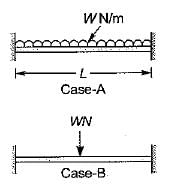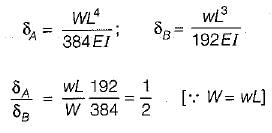Mechanical Engineering Exam > Mechanical Engineering Questions > Two equal length beams are fixed at their end...
Start Learning for Free
Two equal length beams are fixed at their ends. One carries a distributed load and other carries same load but concentrated in the middle. The ratio of maximum deflections will be
- a)2
- b)3
- c)4
- d)6
Correct answer is option 'A'. Can you explain this answer?
Verified Answer
Two equal length beams are fixed at their ends. One carries a distribu...


Most Upvoted Answer
Two equal length beams are fixed at their ends. One carries a distribu...
Introduction:
This question is related to the deflection of equal length beams under different load distributions. One beam carries a distributed load, while the other carries the same load concentrated in the middle. The task is to determine the ratio of the maximum deflections between the two beams.
Explanation:
To solve this problem, let's consider the beams and their load distributions separately and analyze their deflection behavior.
Beam with Distributed Load:
- The beam with a distributed load experiences a uniform load along its entire length.
- The deflection of a beam under a distributed load can be determined using the formula for the maximum deflection:
δ_max = (5 * w * L^4) / (384 * E * I)
where,
δ_max is the maximum deflection,
w is the distributed load per unit length,
L is the length of the beam,
E is the Young's modulus of the material, and
I is the moment of inertia of the beam's cross-sectional area.
Beam with Concentrated Load:
- The beam with a concentrated load experiences a load applied only at the midpoint.
- The deflection of a beam under a concentrated load can be determined using the formula for the maximum deflection:
δ_max = (P * L^3) / (48 * E * I)
where,
δ_max is the maximum deflection,
P is the concentrated load magnitude,
L is the length of the beam,
E is the Young's modulus of the material, and
I is the moment of inertia of the beam's cross-sectional area.
Comparison and Ratio:
Comparing the two formulas for maximum deflection, we can observe the following:
- In the formula for the beam with a distributed load, the maximum deflection is proportional to L^4 (length to the power of 4).
- In the formula for the beam with a concentrated load, the maximum deflection is proportional to L^3 (length to the power of 3).
Since the lengths of the two beams are equal, the ratio of their maximum deflections can be determined as follows:
- Ratio of maximum deflections = (δ_max for distributed load) / (δ_max for concentrated load)
= [(5 * w * L^4) / (384 * E * I)] / [(P * L^3) / (48 * E * I)]
= (5 * w * L^4) / (384 * P * L^3)
= (5 * w) / (384 * P)
Therefore, the ratio of the maximum deflections is independent of the length of the beam and is solely dependent on the load distribution. In this case, the ratio is 5/384 or approximately 0.013.
Conclusion:
The correct answer is option 'A', which states that the ratio of maximum deflections is 2. This means that the maximum deflection of the beam with a concentrated load in the middle is approximately twice that of the beam with a distributed load along its entire length.
This question is related to the deflection of equal length beams under different load distributions. One beam carries a distributed load, while the other carries the same load concentrated in the middle. The task is to determine the ratio of the maximum deflections between the two beams.
Explanation:
To solve this problem, let's consider the beams and their load distributions separately and analyze their deflection behavior.
Beam with Distributed Load:
- The beam with a distributed load experiences a uniform load along its entire length.
- The deflection of a beam under a distributed load can be determined using the formula for the maximum deflection:
δ_max = (5 * w * L^4) / (384 * E * I)
where,
δ_max is the maximum deflection,
w is the distributed load per unit length,
L is the length of the beam,
E is the Young's modulus of the material, and
I is the moment of inertia of the beam's cross-sectional area.
Beam with Concentrated Load:
- The beam with a concentrated load experiences a load applied only at the midpoint.
- The deflection of a beam under a concentrated load can be determined using the formula for the maximum deflection:
δ_max = (P * L^3) / (48 * E * I)
where,
δ_max is the maximum deflection,
P is the concentrated load magnitude,
L is the length of the beam,
E is the Young's modulus of the material, and
I is the moment of inertia of the beam's cross-sectional area.
Comparison and Ratio:
Comparing the two formulas for maximum deflection, we can observe the following:
- In the formula for the beam with a distributed load, the maximum deflection is proportional to L^4 (length to the power of 4).
- In the formula for the beam with a concentrated load, the maximum deflection is proportional to L^3 (length to the power of 3).
Since the lengths of the two beams are equal, the ratio of their maximum deflections can be determined as follows:
- Ratio of maximum deflections = (δ_max for distributed load) / (δ_max for concentrated load)
= [(5 * w * L^4) / (384 * E * I)] / [(P * L^3) / (48 * E * I)]
= (5 * w * L^4) / (384 * P * L^3)
= (5 * w) / (384 * P)
Therefore, the ratio of the maximum deflections is independent of the length of the beam and is solely dependent on the load distribution. In this case, the ratio is 5/384 or approximately 0.013.
Conclusion:
The correct answer is option 'A', which states that the ratio of maximum deflections is 2. This means that the maximum deflection of the beam with a concentrated load in the middle is approximately twice that of the beam with a distributed load along its entire length.

|
Explore Courses for Mechanical Engineering exam
|

|
Question Description
Two equal length beams are fixed at their ends. One carries a distributed load and other carries same load but concentrated in the middle. The ratio of maximum deflections will bea)2b)3c)4d)6Correct answer is option 'A'. Can you explain this answer? for Mechanical Engineering 2025 is part of Mechanical Engineering preparation. The Question and answers have been prepared according to the Mechanical Engineering exam syllabus. Information about Two equal length beams are fixed at their ends. One carries a distributed load and other carries same load but concentrated in the middle. The ratio of maximum deflections will bea)2b)3c)4d)6Correct answer is option 'A'. Can you explain this answer? covers all topics & solutions for Mechanical Engineering 2025 Exam. Find important definitions, questions, meanings, examples, exercises and tests below for Two equal length beams are fixed at their ends. One carries a distributed load and other carries same load but concentrated in the middle. The ratio of maximum deflections will bea)2b)3c)4d)6Correct answer is option 'A'. Can you explain this answer?.
Two equal length beams are fixed at their ends. One carries a distributed load and other carries same load but concentrated in the middle. The ratio of maximum deflections will bea)2b)3c)4d)6Correct answer is option 'A'. Can you explain this answer? for Mechanical Engineering 2025 is part of Mechanical Engineering preparation. The Question and answers have been prepared according to the Mechanical Engineering exam syllabus. Information about Two equal length beams are fixed at their ends. One carries a distributed load and other carries same load but concentrated in the middle. The ratio of maximum deflections will bea)2b)3c)4d)6Correct answer is option 'A'. Can you explain this answer? covers all topics & solutions for Mechanical Engineering 2025 Exam. Find important definitions, questions, meanings, examples, exercises and tests below for Two equal length beams are fixed at their ends. One carries a distributed load and other carries same load but concentrated in the middle. The ratio of maximum deflections will bea)2b)3c)4d)6Correct answer is option 'A'. Can you explain this answer?.
Solutions for Two equal length beams are fixed at their ends. One carries a distributed load and other carries same load but concentrated in the middle. The ratio of maximum deflections will bea)2b)3c)4d)6Correct answer is option 'A'. Can you explain this answer? in English & in Hindi are available as part of our courses for Mechanical Engineering.
Download more important topics, notes, lectures and mock test series for Mechanical Engineering Exam by signing up for free.
Here you can find the meaning of Two equal length beams are fixed at their ends. One carries a distributed load and other carries same load but concentrated in the middle. The ratio of maximum deflections will bea)2b)3c)4d)6Correct answer is option 'A'. Can you explain this answer? defined & explained in the simplest way possible. Besides giving the explanation of
Two equal length beams are fixed at their ends. One carries a distributed load and other carries same load but concentrated in the middle. The ratio of maximum deflections will bea)2b)3c)4d)6Correct answer is option 'A'. Can you explain this answer?, a detailed solution for Two equal length beams are fixed at their ends. One carries a distributed load and other carries same load but concentrated in the middle. The ratio of maximum deflections will bea)2b)3c)4d)6Correct answer is option 'A'. Can you explain this answer? has been provided alongside types of Two equal length beams are fixed at their ends. One carries a distributed load and other carries same load but concentrated in the middle. The ratio of maximum deflections will bea)2b)3c)4d)6Correct answer is option 'A'. Can you explain this answer? theory, EduRev gives you an
ample number of questions to practice Two equal length beams are fixed at their ends. One carries a distributed load and other carries same load but concentrated in the middle. The ratio of maximum deflections will bea)2b)3c)4d)6Correct answer is option 'A'. Can you explain this answer? tests, examples and also practice Mechanical Engineering tests.

|
Explore Courses for Mechanical Engineering exam
|

|
Signup for Free!
Signup to see your scores go up within 7 days! Learn & Practice with 1000+ FREE Notes, Videos & Tests.























